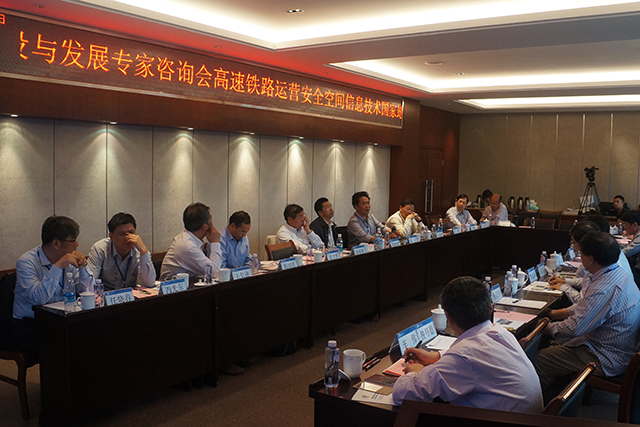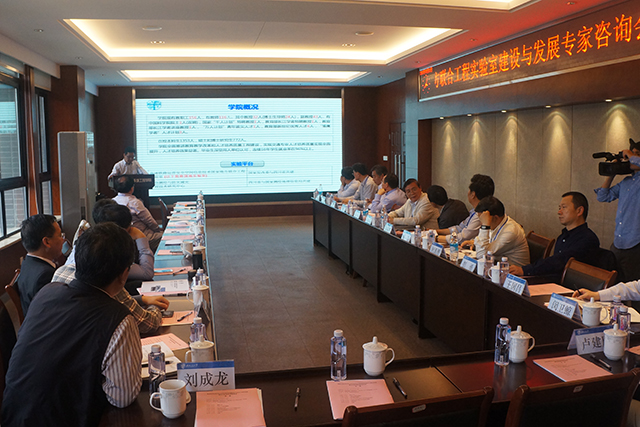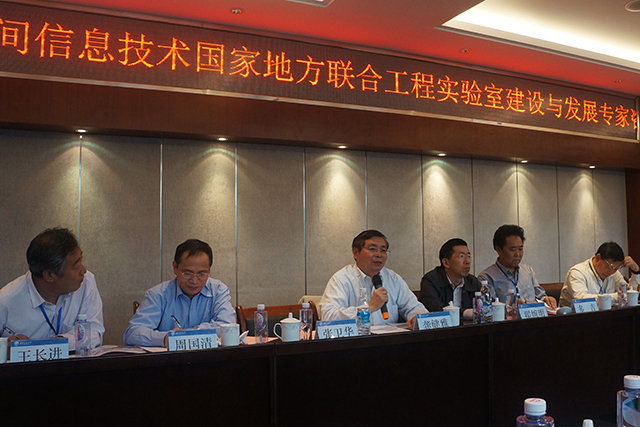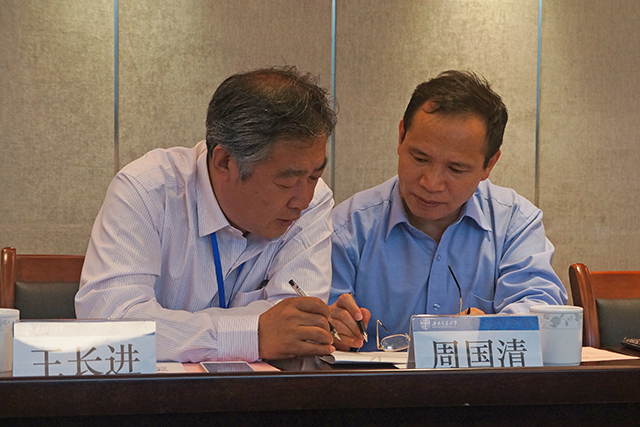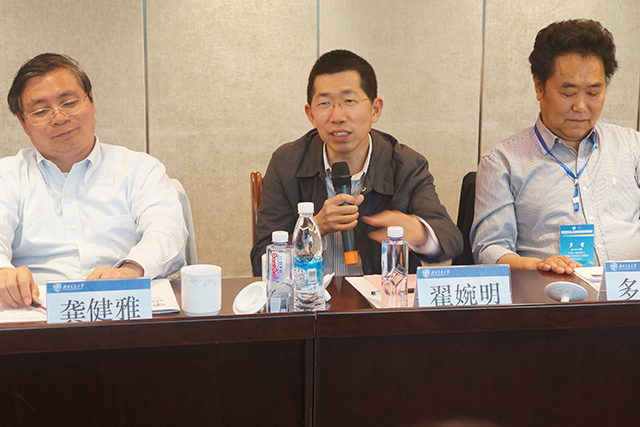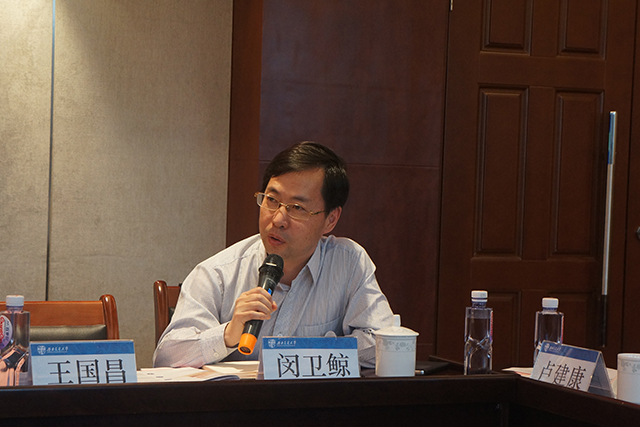“Academic conference of new technology on mapping & surveying, geology and environment for high-speed railway”— Experts consultation on the construction and development of laboratory was successfully held by State-Province Joint Engineering Laboratory in Spatial Information Technology for High-Speed Railway Safety (SPJEL) in the FGEE’s first meeting room 4520 on May 14th.
The academician and experts attending the meeting includes Yu Pu from Southweest Jiaotong University, Ji Duo from Chinese Academy of Engineering, Jianya Gong,Manchao He and Wanming Zhai from Chinese Academy of Sciences, “Thousand Talent program” scholar Guoqing Zhou, Guochang Wang fromChina Railway Research Instituteco., Ltd, Yong Peng fromEnvironmental Protection Bureau of Sichuan province, Lizhong Yang from Southwest Jiaotong University, Weijing Min and Jiangkang Lu fromChina Railway Eryuan Engineering Group CO., LTD, Xiaochun Ren fromChina Railway First Survey & Design Institute Group CO.,LTD, Guangdong Feng from China Railway Fourth Survey & Design Institute Group CO.,LTD, “Thousand Talent program” scholar Prof. Zhilin Li from Southwest Jiaotong University FGEE, Ruitang Xu form FGEE, Dean of our faculty Guoxiang Liu, deputy dean of our faculty Xiewen Hu, Feng Ouyang, Hua Qi, Prof. Qing Zhu, Prof. Chenglong Liu, and Prof.Gongqian Cheng.
SPJEL was built to respond to the national strategies “JingJinJi Coordinated Development”, “the Belt and Road”, “Yangtze River Economic Belt Construction”, and west strategies “West Development”, “Transportation first”, “Construct the ChengYu Economy Growth Pole”. SPJEL was listed in the high technology industry development plan by National Development and Reform Commission in November 2013. SPJEL had been working for becoming national innovation platform of important spatial information technology for high-speed railway safety under the support of our university and our faulty in the past two years. Currently, the construction and development of the laboratory is in its critical stages. This meeting aimed to invite outstanding academician and experts to give advice on the laboratory’s construction.
The meeting was hosted by Wei Che from SPJEL. Yu Pu expressed heated welcome and appreciations to the experts and scholars in his welcome speech. He agreed that the state-province joint laboratory was important to the implementation of the strategies “High-speed Railway Export” and “the Belt and Road”. He proposed hopes that the research institutes led by FGEE could construct SPJEL which was suitable for china’s current situation and have its independent intellectual property rights, so that FGEE can develop well in the long run.
Guoxiang Liu reported the construction of the laboratory on five aspects including faculty survey, laboratory survey, the laboratory construction plan, the achievements of the laboratory, and the external communication and cooperation. The overall objectives of SPJEL were “building the first national integrated platform of spatial information technology for high-speed railway safety, which oriented to the requirement of national high-speed railway construction and operation safety guarantee”, “building high-speed railway spatial information technology centers which had systematic large-scale and was national first-rate and internationally advanced” (The overall objectives have three stages). The main three research fields of the laboratory included the acquirement and processing of high-speed railway spatial information, high-speed railway route safety, the warning and emergency response of high-speed railway geological environmental disasters. The laboratory had 8 research centers including high-speed railway satellite positioning, track geometry inspection technology, and 19 experiment platform including UAV (unmanned aerial vehicle) disaster-information fast acquisition, remote sensing detection of geographical environmental hidden danger. Besides, SPJEL had plans to build the first national platform which can statically and dynamically detect and discern the geographical environmental hidden-dangers in the areas along the high-speed railway route, and to build the first international research base of rail harshness-detection technology and track-inspection equipment development and machine calibration.
The experts attending the meeting agreed that FGEE has leapt forward since established in 2010. They agreed that SPJEL led by Zhilin Li had accomplished remarkable achievements on team orientation, talent cultivation, technology research and development etc. Jianya Gong, Manchao He, Ji Duo, Wanming Zhai, Guoqing Zhou, Changjin Wei, Xiaochun Ren, Guangdong Feng, Weijing Min, Jiankang Lu offered valuable advice for the laboratory’s construction and long-term development. The main suggestions included,
First, pinpoint development orientation. The attending experts thought that the laboratory’s current orientation is basically correct, but whether the space-earth-sky three orientations could be specialized needs to be specially considered. They thought that the name of the laboratory was a little bit lengthy, and thus might make the orientations not clear. It should emphasize the orientation of “engineering laboratory”. (Note: the laboratory ‘s name has been approved by the national development and reform commission and thus temporally cannot be changed .)
Second, make the specific development directions. They agreed that the direction was the applications and popularizations of spatial information technology for high-speed railway safety. However, the directions were still not specific. They suggested emphasizing the key points and characteristics. The laboratory should encourage research teams to fully use the research environment and experiment platforms, form systematic large-scale research technology, proceed to the stages of real-time dynamic-detection technology research and development.
Third, transform the development mechanism. Spatial information technology was an important part of high-speed railway development. The next step would be critical to realize the long-term development. At present, the large-scale constructions of spatial-information technology are decreasing. The research and development institutions were also affected.
Four, realize technology industrialization. The laboratory’s construction and development needed large amount of money to prepare fields, buy devices, employ workers, and thus the problems such as capital turnover needed to be guaranteed. Realizing technology industrialization is undoubtedly a practical approach to carry out the long-term development of the research teams in universities. The experts suggested that the laboratory should cooperate with the local enterprises or open tech companies and operate projects under the rules of the State Council and Ministry of Education. Laboratory should absorb and reasonably transform recourses, realize the maximization of academic benefit, economic benefit, and social benefit. (Note: SPJEL are cooperating with the science park of SWJTU and trying to realize industrialization ASAP)
Five, reasonably allocate asserts and resources. At present, SPJEL depended on FGEE. so SPJEL needed to distinguish the university’s asserts from faculty’s asserts. Thus, they suggested perfecting the asserts subdivide and management system, make the scheme for subdividing the asserts, also make the dualization of the university’s asserts and the faculty’s asserts clear. The aim was to utilize the national resources scientifically and reasonably.
Six, motivate the diversification of research projects. The laboratory should make it clear that the state-province joint laboratory was to guarantee the national fundamental researches and the requirements of major developments. Firstly, the Tibet Autonomous Region was not included in the plan of national high-speed railway technology development. So they suggested that the laboratory should consider the full usage of the research and development platform, the relevance of disciplines. The laboratory should pay attentions to the spatial information technology of railway operation safety of not only universality and regional, but also some special areas like Sichuan-Tibet route which faces special plateau geological conditions such as high and low temperature, hot spring, underground water and permafrost strata. They suggested that, the laboratory could cooperate with the experts and research teams from Tibet and apply joint programs, work together to help perfect the development strategy of national railway development. Secondly, the laboratory should focus on not only the engineering materials and structures before the operations of high-speed railway, but also building the emergency mechanism and treatment system to guarantee the omnibearing operation safety. Thirdly, the laboratory should also consider the social environment problems such as disease spreading in the high-speed railway operation safety.
Seven, scientifically plan the teams and platforms. The laboratory should distinguish the teaching members and research members, distinguish major members and part-time workers in the innovation teams, and also distinguish research teams from other organizations. The research projects should be divided into the related research centers. The academic achievements of each center should be integrated so that integrated platforms can be formed and the achievements could be transformed into productions. Thus, the laboratory could be constructed into integrated system which can adapt to the national high-speed railway development strategy.
Eight, perfect the preparation for acceptance. Firstly, revealed information such as the organizational architecture, personnel allocation, capital sources and spends. Secondly, finished the report and inform programs of environment assessment, feasibility assessment of the construction plan etc. Thirdly, make the effective outcomes and the accomplish circumstance of the tasks clear. Fourthly, implement the hardware facility such as the offices and experimental equipment. Fifthly, highlight the development goals such as the number of cultivated talents, the proportion of the prize-winning achievements and applied patents.
The academic leaders and team members such asZhilin Li listened to the guests’ suggestions on laboratory construction, team management, and scientific development etc. They agreed the shortcomings which existed in the construction of state-province joint laboratory and were proposed by the guests from the experts’ view. Zhilin Li etc. also expressed appreciations to the invitation of academic communication in terms of cooperation. The expert consultation for the construction and development of the state-province joint engineering laboratory in spatial information technology for high-speed railway safety came to a successfully conclusion.
